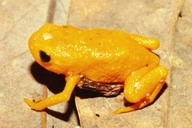|
Brachycephalus ephippium (Spix, 1824)
Pumpkin Toadlet, Spix's Saddleback Toad, Botao de Ouro, Sapinho Dourado | family: Brachycephalidae genus: Brachycephalus |
 © 2001 Germano Woehl Jr. (1 of 11) |
|
|
|
Description Distribution and Habitat Country distribution from AmphibiaWeb's database: Brazil
Life History, Abundance, Activity, and Special Behaviors These frogs are diurnal during the rainy season. Generally they walk about on the leaf litter, but will find a low perch if the humidity approaches 100%. They clean themselves by wiping their head and body with their limbs. During the dry season, they remain under logs or leaf litter (Pombal, 2003). Males are highly territorial during the rainy season. When another frog approaches, the male frog signals both by vocalization and by moving an arm up and down in front of its own eye. If the intruder is a male and remains, the male frog embraces and wrestles the intruder, pushing it away. Presentation of mirrors to male frogs elicited visual displays in almost all cases, and rarely, attacks, but no vocalizations. Presentation of mirrors to two female frogs resulted in a visual display by one of the females (Pombal et al., 1994). Breeding takes place during the rainy season. Advertisement calls consist of a continuous series of buzzes lasting two to six minutes. The call begins with the first notes having five or six pulses, and ending with notes that have as many as fifteen pulses. However, most of the notes have ten pulses and an almost constant pitch. Calling males elevate their body, displaying a "high posture". Visual signals may be more important than vocal signals in this species since the vocalization appears to be softer in volume than background environmental noise (Pombal et al., 1994). The male grasps the female and walks behind her as she selects a site for egg deposition in the leaf litter or under a log. Initially amplexus is inguinal (around the waist), with the male then moving forward and changing to an almost axillary position (just below the armpits). Females lay up to five large, yellowish white eggs over a period of about half an hour. When the males leave the mating site, the females roll the eggs about using their hind feet. Dirt adheres to the egg surfaces, helping to camouflage them. The females then leave the eggs unattended. Development is direct (lacking the tadpole stage), with hatching of miniature toadlets occurring in about two months. The newly hatched toadlets still have a vestigial tail (Pombal, 2003). Pumpkin Toadlets are active foragers. The adult diet consists of small arthropods, primarily collembolans (springtails), but also including mites and insect larvae (Pombal, 2003). Trends and Threats Relation to Humans Possible reasons for amphibian decline General habitat alteration and loss Comments This species was featured as News of the Week on 22 April 2019: Fluorescence is a well known phenomenon in marine organisms, which only recently has been found in terrestrial vertebrates; the first report of fluorescence in amphibians was described in the lymph and skin glands in Boana punctatus and B. atlantica (Taboada et al. 2017). Goutte et al. (2019) reports another amphibian fluorescence: this time in the dermal bones of two species of pumpkin toadlets, Brachycephalus ephippium and B. pitanga. When exposed to intense UV-light, they found the intensity of fluorescence increases with the maturity of the frog as the epithelial layer co-ossifies with the bones of the head and back. Given earlier findings (Goutte et al. 2017) that these two species were unable to hear their own advertisement calls, and instead rely on visual cues, such as hand-waving and mouth-gaping for mating, they hypothesize that the fluorescence in these species may be used to enhance intraspecific visual communication. However, analysis of Brachycephalus vision is needed to test this hypothesis, and an alternative hypothesis is that the fluorescence enhances aposematic warnings of the toadlets' toxicity to predators that see fluorescence in natural light, such as birds and spiders (Written by Ann T. Chang).
References
Bornschein, M. R., Pie, M. R., Teixeira, L. (2019). "Conservation status of Brachycephalus toadlets (Anura: Brachycephalidae) from the Brazilian Atlantic rainforest.” Diversity, 11(150), 1-29. doi: 10.3390/d11090150 [link] Pombal, J. P. Jr., Sazima, I., and Haddad, C. F. B. (1994). "Breeding behavior of the pumpkin toadlet, Brachycephalus ephippium (Brachycephalidae)." Journal of Herpetology, 28, 516-519. [link] Pombal, J. P., Jr. (2003). ''Pumpkin toadlet, Brachycephalus ephippium.'' Grzimek's Animal Life Encyclopedia, Volume 6, Amphibians. 2nd edition. M. Hutchins, W. E. Duellman, and N. Schlager, eds., Gale Group, Farmington Hills, Michigan. Sebben, A., Schwartz, C.A., Valente, D., and Mendes, E.G.A. (1986). ''Tetrodotoxin-like substance found in the Brazilian frog Brachycephalus ephippium.'' Toxicon, 24, 799-806. Originally submitted by: Peera Chantasirivisal (first posted 2005-11-01) Life history by: Michelle S. Koo (updated 2022-07-24)
Trends and threats by: Michelle S. Koo (updated 2022-07-24)
Edited by: Kellie Whittaker, Ann T. Chang, Michelle S. Koo (2022-07-24) Species Account Citation: AmphibiaWeb 2022 Brachycephalus ephippium: Pumpkin Toadlet <https://amphibiaweb.org/species/2033> University of California, Berkeley, CA, USA. Accessed Apr 19, 2024.
Feedback or comments about this page.
Citation: AmphibiaWeb. 2024. <https://amphibiaweb.org> University of California, Berkeley, CA, USA. Accessed 19 Apr 2024. AmphibiaWeb's policy on data use. |



 Map of Life
Map of Life